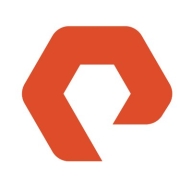

Pure FlashArray X NVMe and Pavilion HyperParallel Flash Array are competing storage solutions. Pavilion HyperParallel has an edge in features and performance, while Pure FlashArray X NVMe excels in ease of deployment and support.
Features: Pure FlashArray X NVMe offers robust snapshot capabilities, simplified management, and strong data reduction. Pavilion HyperParallel Flash Array is noted for its high-speed data access, extensive scalability, and advanced analytics capabilities. Pavilion's performance-oriented design gives it an upper hand in feature set.
Room for Improvement: Users of Pure FlashArray X NVMe suggest improvements in firmware updates, integration options, and enhanced analytics. Pavilion HyperParallel users point to enhancing documentation, refining technical support, and improving user interface. Pavilion’s technical support needs more attention.
Ease of Deployment and Customer Service: Pure FlashArray X NVMe users praise its swift deployment and reliable customer assistance. Pavilion HyperParallel, though powerful, has a steeper learning curve and mixed feedback on support. Pure FlashArray X NVMe has an advantage in ease of deployment and customer service.
Pricing and ROI: Pure FlashArray X NVMe users find it cost-effective with a good balance between setup costs and ROI. Pavilion HyperParallel, while pricier, offers significant ROI due to its superior performance capabilities. Pavilion is seen as justifying its price through exceptional ROI.

Pavilion HyperParallel Data Platform
The Pavilion HyperParallel Data Platform™ dramatically accelerates what organizations achieve by delivering universally unmatched storage performance, in an incredibly compact solution while reducing data center costs and complexity. Unrivaled flexibility for multiple data types and protocols, along with broad ecosystem integration, ensure that every customer has choice and control.
What is the Pavilion HyperParallel Data Platform
The Pavilion HyperParallel Data Platform is comprised of the Pavilion HyperParallel Flash Array™ and Pavilion HyperOS™. The Pavilion HyperParallel Flash Array leverages a unique, switch-based architecture to create a multi-controller solution that delivers an unmatched combination of high performance, ultra-low latency, and storage density. Pavilion HyperOS is a powerful, purpose-built storage operating system designed to unlock the power of the multi-controller Pavilion HyperParallel Flash Array, which delivers scalability and flexibility that no other solution can offer.
Pavilion HyperParallel Data Platform Data Sheet
Download the Pavilion HyperParallel Data Platform data sheet. Updated: December 2020
Pure Storage FlashArray//X is the world’s first enterprise-class, all-NVMe flash storage array. It represents a new class of storage – shared accelerated storage, which is a term coined by Gartner – that delivers major breakthroughs in performance, simplicity, and consolidation.
We monitor all NVMe All-Flash Storage Arrays reviews to prevent fraudulent reviews and keep review quality high. We do not post reviews by company employees or direct competitors. We validate each review for authenticity via cross-reference with LinkedIn, and personal follow-up with the reviewer when necessary.